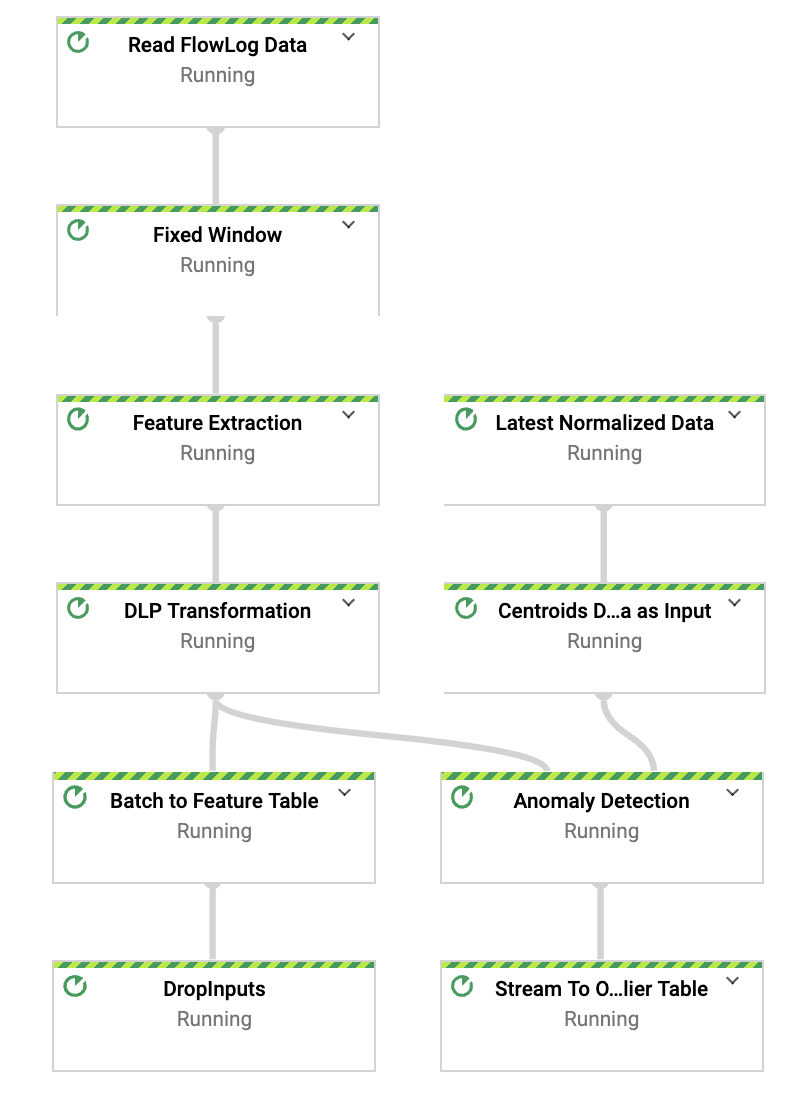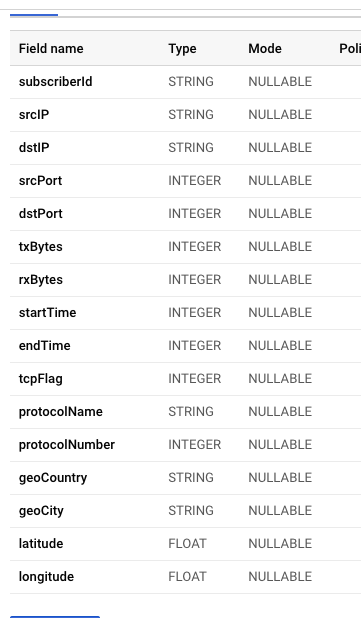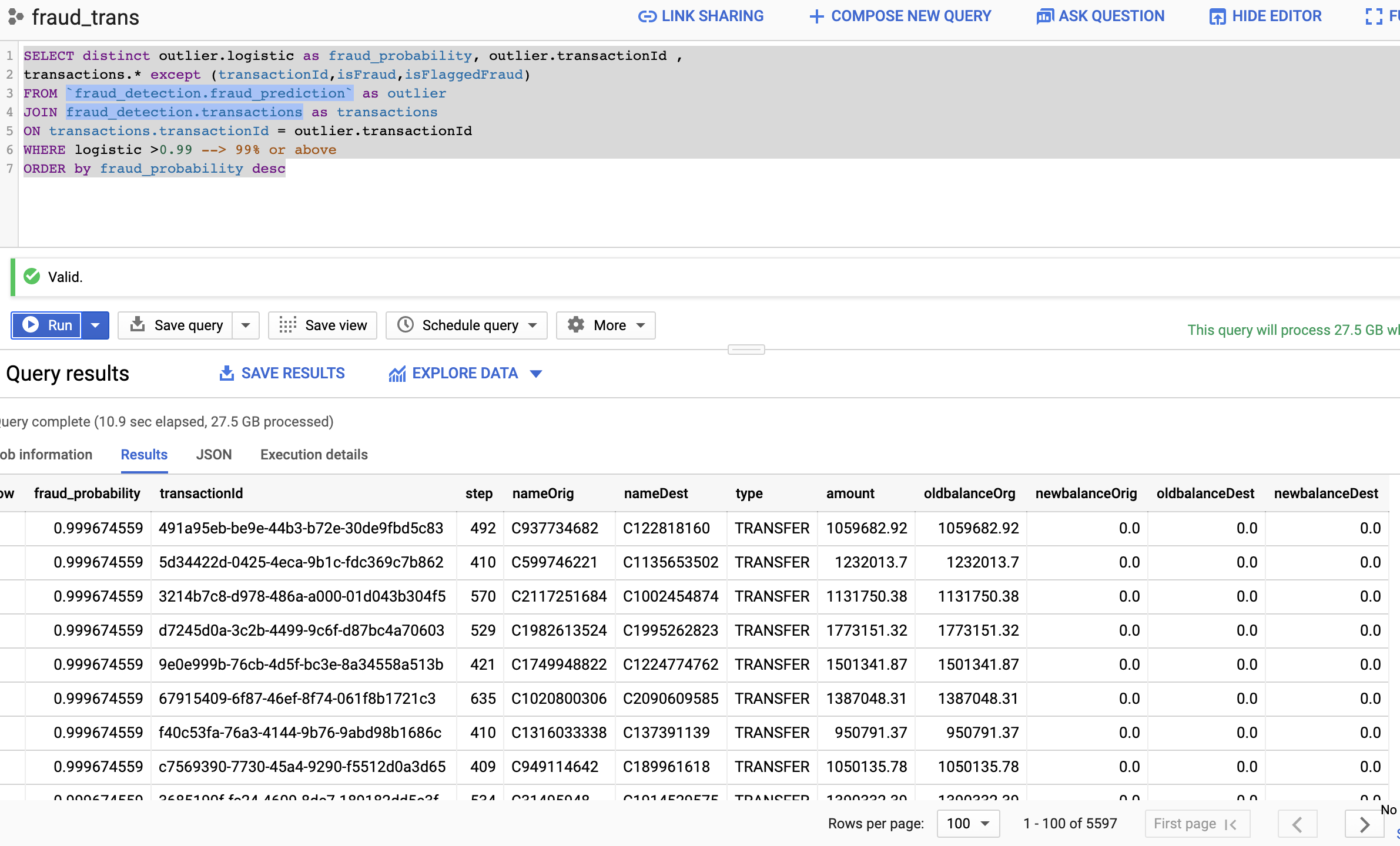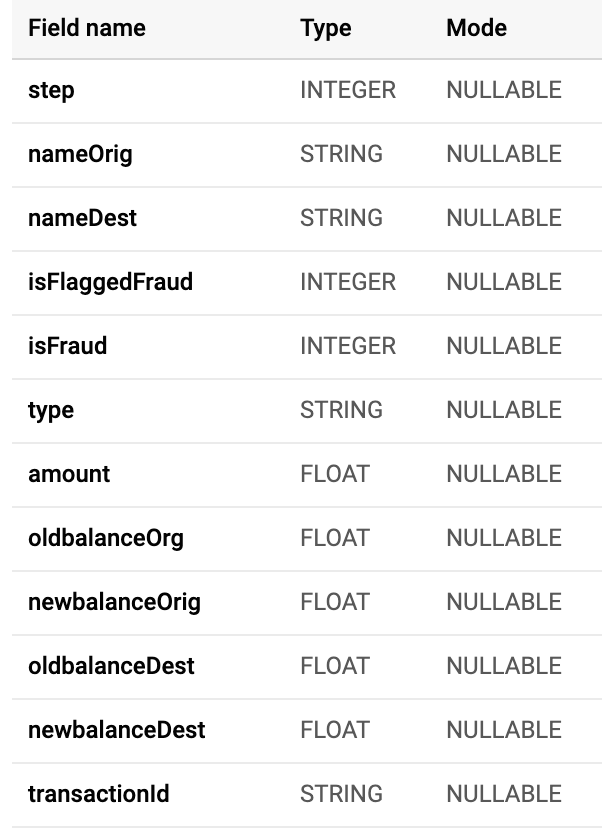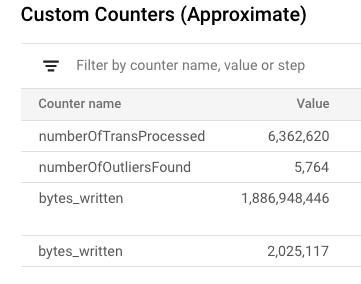This repo provides a reference implementation of a Cloud Dataflow streaming pipelines that integrates with BigQuery ML, Cloud AI Platform, and AutoML (coming soon!) to perform anomaly detection use case as part of real time AI pattern. It contains reference implementations for the following real time anomaly detection use cases:
- Finding anomalous behaviour in netflow log to identify cyber security threat for a Telco use case.
- Finding anomalous transaction to identify fraudulent activities for a Financial Service use case.
This section of the repo contains a reference implementation of an ML based Network Anomaly Detection solution by using Pub/Sub, Dataflow, BQML & Cloud DLP. It uses an easy to use built in K-Means clustering model as part of BQML to train and normalize netflow log data. Key part of the implementation uses Dataflow for feature extraction & real time outlier detection which has been tested to process over 20TB of data. (250k msg/sec). Finally, it also uses Cloud DLP to tokenize IMSI (international mobile subscriber identity) number as the streaming Dataflow pipeline ingests millions of netflow log form Pub/Sub.
Securing its internal network from malware and security threats is critical at many customers. With the ever changing malware landscape and explosion of activities in IoT and M2M, existing signature based solutions for malware detection are no longer sufficient. This PoC highlights an ML based network anomaly detection solution using PubSub, Dataflow, BQ ML and DLP to detect mobile malware on subscriber devices and suspicious behaviour in wireless networks.
This solution implements the reference architecture highlighted below. You will execute a dataflow streaming pipeline to process netflow log from GCS and/or PubSub to find outliers in netflow logs in real time. This solution also uses a built in K-Means Clustering Model created by using BQ-ML. To see a step-by-step tutorial that walks you through implementing this solution, see Building a secure anomaly detection solution using Dataflow, BigQuery ML, and Cloud Data Loss Prevention.
In summary, you can use this solution to demo following 3 use cases :
- Streaming Analytics at Scale by using Dataflow/Beam. (Feature Extraction & Online Prediction).
- Making Machine Learning easy to do by creating a model by using BQ ML K-Means Clustering.
- Protecting sensitive information e.g:"IMSI (international mobile subscriber identity)" by using Cloud DLP crypto based tokenization.
gcloud services enable storage_component
gcloud services enable dataflow
gcloud services enable cloudbuild.googleapis.com
gcloud config set project <project_id>
export PROJECT_NUMBER=$(gcloud projects list --filter=${PROJECT_ID} --format="value(PROJECT_NUMBER)")
gcloud projects add-iam-policy-binding ${PROJECT_ID} --member serviceAccount:$PROJECT_NUMBER@cloudbuild.gserviceaccount.com --role roles/editor
gcloud projects add-iam-policy-binding ${PROJECT_ID} --member serviceAccount:$PROJECT_NUMBER@cloudbuild.gserviceaccount.com --role roles/storage.objectAdmin
export DATASET=<var>bq-dataset-name</var>
export SUBSCRIPTION_ID=<var>subscription_id</var>
export TOPIC_ID=<var>topic_id</var>
export DATA_STORAGE_BUCKET=${PROJECT_ID}-<var>data-storage-bucket</var>
You can also export DLP template and batch size to enable DLP transformation in the pipeline
- Batch Size is in bytes and max allowed is less than 520KB/payload
export DEID_TEMPLATE=projects/{id}/deidentifyTemplates/{template_id}
export BATCH_SIZE = 350000
gcloud builds submit scripts/. --config scripts/cloud-build-demo.yaml --substitutions \
_DATASET=$DATASET,\
_DATA_STORAGE_BUCKET=$DATA_STORAGE_BUCKET,\
_SUBSCRIPTION_ID=${SUBSCRIPTION_ID},\
_TOPIC_ID=${TOPIC_ID},\
_API_KEY=$(gcloud auth print-access-token)
If you have all other resources like BigQuery tables, PubSub topic and subscriber, GCS bucket already exist or created before, you can use the command below to trigger the pipeline by using a public image. This may be helpful for run the pipeline for live demo.
Generate 10k msg/sec of random net flow log data:
gcloud beta dataflow flex-template run data-generator --project=<project_id> --region=<region> --template-file-gcs-location=gs://df-ml-anomaly-detection-mock-data/dataflow-flex-template/dynamic_template_data_generator_template.json --parameters=autoscalingAlgorithm="NONE",numWorkers=5,maxNumWorkers=5,workerMachineType=n1-standard-4,qps=10000,schemaLocation=gs://df-ml-anomaly-detection-mock-data/schema/next-demo-schema.json,eventType=net-flow-log,topic=projects/<project_id>/topics/events
Generate 1k msg/sec of random outlier data:
gcloud beta dataflow flex-template run data-generator --project=<project_id> --region=<region> --template-file-gcs-location=gs://df-ml-anomaly-detection-mock-data/dataflow-flex-template/dynamic_template_data_generator_template.json --parameters=autoscalingAlgorithm="NONE",numWorkers=5,maxNumWorkers=5,workerMachineType=n1-standard-4,qps=1000,schemaLocation=gs://df-ml-anomaly-detection-mock-data/schema/next-demo-schema-outlier.json,eventType=net-flow-log,topic=projects/<project_id>/topics/<topic_id>
Trigger Anomaly Detection Pipeline:
gcloud beta dataflow flex-template run "anomaly-detection" --project=<project_id>--region=us-central1 --template-file-gcs-location=gs://df-ml-anomaly-detection-mock-data/dataflow-flex-template/dynamic_template_secure_log_aggr_template.json --parameters=autoscalingAlgorithm="NONE",numWorkers=20,maxNumWorkers=20,workerMachineType=n1-highmem-4,subscriberId=projects/<project_id>/subscriptions/events-sub,tableSpec=<project_id>:<dataset_name>.cluster_model_data,batchFrequency=10,customGcsTempLocation=gs://df-tmp-data/temp,tempLocation=gs://df-temp-data/temp,clusterQuery=gs://<path>/normalized_cluster_data.sql,outlierTableSpec=<project_id>:<dataset_name>.outlier_data,inputFilePattern=gs://df-ml-anomaly-detection-mock-data/flow_log*.json,enbaleStreamingEngine=true,windowInterval=5,writeMethod=FILE_LOADS,streaming=true
gradle run -DmainClass=com.google.solutions.df.log.aggregations.StreamingBenchmark \
-Pargs="--streaming --runner=DataflowRunner --project=${PROJECT_ID} --autoscalingAlgorithm=NONE --workerMachineType=n1-standard-4 --numWorkers=3 --maxNumWorkers=3 --qps=1000 --schemaLocation=gs://df-ml-anomaly-detection-mock-data/schema/netflow_log_json_schema.json --eventType=netflow --topic=${TOPIC_ID} --region=us-central1"
gcloud pubsub topics publish events --message "{\"subscriberId\": \"00000000000000000\", \
\"srcIP\": \"12.0.9.4\", \
\"dstIP\": \"12.0.1.3\", \
\"srcPort\": 5000, \
\"dstPort\": 3000, \
\"txBytes\": 150000, \
\"rxBytes\": 40000, \
\"startTime\": 1570276550, \
\"endTime\": 1570276550, \
\"tcpFlag\": 0, \
\"protocolName\": \"tcp\", \
\"protocolNumber\": 0}"
Please stop/cancel the dataflow pipeline manually from the UI.
Sample Input Data
{
\"subscriberId\": \"100\",
\"srcIP\": \"12.0.9.4",
\"dstIP\": \"12.0.1.2\",
\"srcPort\": 5000,
\"dstPort\": 3000,
\"txBytes\": 15,
\"rxBytes\": 40,
\"startTime\": 1570276550,
\"endTime\": 1570276559,
\"tcpFlag\": 0,
\"protocolName\": \"tcp\",
\"protocolNumber\": 0
},
{
\"subscriberId\": \"100\",
\"srcIP\": \"12.0.9.4\",
\"dstIP\": \"12.0.1.2\",
\"srcPort\": 5000,
\"dstPort\": 3000,
\"txBytes\": 10,
\"rxBytes\": 40,
\"startTime\": 1570276650,
\"endTime\": 11570276750,,
\"tcpFlag\": 0,
\"protocolName\": \"tcp\",
\"protocolNumber\": 0
}
- Added processing timestamp.
- Group by destination subnet and subscriberId
- Number of approximate unique IP
- Number of approximate unique port
- Number of unique records
- Max, min, avg txBytes
- Max, min, avg rxBytes
- Max, min, avg duration
{
"transaction_time": "2019-10-27 23:22:17.848000",
"subscriber_id": "100",
"dst_subnet": "12.0.1.2/22",
"number_of_unique_ips": "1",
"number_of_unique_ports": "1",
"number_of_records": "2",
"max_tx_bytes": "15",
"min_tx_bytes": "10",
"avg_tx_bytes": "12.5",
"max_rx_bytes": "40",
"min_rx_bytes": "40",
"avg_rx_bytes": "40.0",
"max_duration": "100",
"min_duration": "9",
"avg_duration": "54.5"
}
Group.<Row>byFieldNames("subscriberId", "dstSubnet")
.aggregateField(
"srcIP",
new ApproximateUnique.ApproximateUniqueCombineFn<String>(
SAMPLE_SIZE, StringUtf8Coder.of()),
"number_of_unique_ips")
.aggregateField(
"srcPort",
new ApproximateUnique.ApproximateUniqueCombineFn<Integer>(
SAMPLE_SIZE, VarIntCoder.of()),
"number_of_unique_ports")
.aggregateField("srcIP", Count.combineFn(), "number_of_records")
.aggregateField("txBytes", new AvgCombineFn(), "avg_tx_bytes")
.aggregateField("txBytes", Max.ofIntegers(), "max_tx_bytes")
.aggregateField("txBytes", Min.ofIntegers(), "min_tx_bytes")
.aggregateField("rxBytes", new AvgCombineFn(), "avg_rx_bytes")
.aggregateField("rxBytes", Max.ofIntegers(), "max_rx_bytes")
.aggregateField("rxBytes", Min.ofIntegers(), "min_rx_bytes")
.aggregateField("duration",new AvgCombineFn(), "avg_duration")
.aggregateField("duration", Max.ofIntegers(), "max_duration")
.aggregateField("duration", Min.ofIntegers(), "min_duration"));
Please use the json schema (aggr_log_table_schema.json) to create the table in BQ. Cluster_model_data table is partition by 'ingestion timestamp' and clustered by dst_subnet and subscriber_id.
CREATE or REPLACE TABLE network_logs.train_data as (select * from {dataset_name}.cluster_model_data
where _PARTITIONDATE between 'date_from' AND 'date_to';
--> create model
CREATE OR REPLACE {dataset_name}.log_cluster options(model_type='kmeans', num_clusters=4, standardize_features = true)
AS select * except (transaction_time, subscriber_id, number_of_unique_ips, number_of_unique_ports, dst_subnet)
from network_logs.train_data;
- Predict on the train dataset to get the nearest distance from centroid for each record.
- Calculate the STD DEV for each point to normalize
- Store them in a table dataflow pipeline can use as side input
with centroid_details AS (
select centroid_id,array_agg(struct(feature as name, round(numerical_value,1) as value) order by centroid_id) AS cluster
from ML.CENTROIDS(model network_logs.log_cluster_2)
group by centroid_id),
cluster as (select centroid_details.centroid_id as centroid_id,
(select value from unnest(cluster) where name = 'number_of_records') AS number_of_records,
(select value from unnest(cluster) where name = 'max_tx_bytes') AS max_tx_bytes,
(select value from unnest(cluster) where name = 'min_tx_bytes') AS min_tx_bytes,
(select value from unnest(cluster) where name = 'avg_tx_bytes') AS avg_tx_bytes,
(select value from unnest(cluster) where name = 'max_rx_bytes') AS max_rx_bytes,
(select value from unnest(cluster) where name = 'min_rx_bytes') AS min_rx_bytes,
(select value from unnest(cluster) where name = 'avg_rx_bytes') AS avg_rx_bytes,
(select value from unnest(cluster) where name = 'max_duration') AS max_duration,
(select value from unnest(cluster) where name = 'min_duration') AS min_duration,
(select value from unnest(cluster) where name = 'avg_duration') AS avg_duration
from centroid_details order by centroid_id asc),
predict as (select * from ML.PREDICT(model {dataset_name}.log_cluster_2, (select * from network_logs.train_data)))
select c.centroid_id as centroid_id,
(stddev((p.number_of_records-c.number_of_records)
+(p.max_tx_bytes-c.max_tx_bytes)
+(p.min_tx_bytes-c.min_tx_bytes)
+(p.avg_tx_bytes-c.min_tx_bytes)
+(p.max_rx_bytes-c.max_rx_bytes)
+(p.min_rx_bytes-c.min_rx_bytes)
+(p.avg_rx_bytes-c.min_rx_bytes)
+(p.max_duration-c.max_duration)
+(p.min_duration-c.min_duration)
+(p.avg_duration-c.avg_duration)))as normalized_dest,
any_value(c.number_of_records) as number_of_records,
any_value(c.max_tx_bytes) as max_tx_bytes,
any_value(c.min_tx_bytes) as min_tx_bytes ,
any_value(c.avg_tx_bytes) as avg_tx_bytes,
any_value(c.max_rx_bytes) as max_rx_bytes,
any_value(c.min_tx_bytes) as min_rx_bytes,
any_value(c.avg_rx_bytes) as avg_rx_bytes,
any_value(c.avg_duration) as avg_duration,
any_value(c.max_duration) as max_duration,
any_value(c.min_duration) as min_duration
from predict as p
inner join cluster as c on c.centroid_id = p.centroid_id
group by c.centroid_id);
- Find the nearest distance from the centroid.
- Calculate STD DEV between input and centroid vectors
- Find the Z Score (difference between a value in the sample and the mean, and divide it by the standard deviation)
- A score of 2 (2 STD DEV above the mean is an OUTLIER).
gcloud services enable dataflow
gcloud services enable big query
gcloud services enable storage_component
Dataset
bq --location=US mk -d \
--description "Network Logs Dataset \
<dataset_name>
Aggregation Data Table
bq mk -t --schema aggr_log_table_schema.json \
--time_partitioning_type=DAY \
--clustering_fields=dst_subnet, subscriber_id \
--description "Network Log Partition Table" \
--label myorg:prod \
<project>:<dataset_name>.cluster_model_data
Outlier Table
bq mk -t --schema outlier_table_schema.json \
--label myorg:prod \
<project>:<dataset_name>.network_logs.outlier_data
To Build
gradle spotlessApply -DmainClass=com.google.solutions.df.log.aggregations.SecureLogAggregationPipeline
gradle build -DmainClass=com.google.solutions.df.log.aggregations.SecureLogAggregationPipeline
gcloud auth configure-docker
gradle jib --image=gcr.io/${PROJECT_ID}/df-ml-anomaly-detection:latest -DmainClass=com.google.solutions.df.log.aggregations.SecureLogAggregationPipeline
To Run
gcloud beta dataflow flex-template run "anomaly-detection" \
--project=${PROJECT_ID} \
--region=us-central1 \
--template-file-gcs-location=gs://${DF_TEMPLATE_CONFIG_BUCKET}/dynamic_template_secure_log_aggr_template.json \
--parameters=autoscalingAlgorithm="NONE",\
numWorkers=5,\
maxNumWorkers=5,\
workerMachineType=n1-highmem-4,\
subscriberId=projects/${PROJECT_ID}/subscriptions/${SUBSCRIPTION_ID},\
tableSpec=${PROJECT_ID}:${DATASET_NAME}.cluster_model_data,\
batchFrequency=2,\
customGcsTempLocation=gs://${DF_TEMPLATE_CONFIG_BUCKET}/temp,\
tempLocation=gs://${DF_TEMPLATE_CONFIG_BUCKET}/temp,\
clusterQuery=gs://${DF_TEMPLATE_CONFIG_BUCKET}/normalized_cluster_data.sql,\
outlierTableSpec=${PROJECT_ID}:${DATASET_NAME}.outlier_data,\
inputFilePattern=gs://df-ml-anomaly-detection-mock-data/flow_log*.json,\
workerDiskType=compute.googleapis.com/projects/${PROJECT_ID}/zones/us-central1-b/diskTypes/pd-ssd,\
diskSizeGb=5,\
windowInterval=10,\
writeMethod=FILE_LOADS,\
streaming=true
Publish mock log data at 250k msg/sec
Schema used for load test:
{
"subscriberId": "{{long(1111111111,9999999999)}}",
"srcIP": "{{ipv4()}}",
"dstIP": "{{subnet()}}",
"srcPort": {{integer(1000,5000)}},
"dstPort": {{integer(1000,5000)}},
"txBytes": {{integer(10,1000)}},
"rxBytes": {{integer(10,1000)}},
"startTime": {{starttime()}},
"endTime": {{endtime()}},
"tcpFlag": {{integer(0,65)}},
"protocolName": "{{random("tcp","udp","http")}}",
"protocolNumber": {{integer(0,1)}}
}
To Run:
export PROJECT_ID=$(gcloud config get-value project)
export TOPIC_ID=<var>topic-id</var>
gcloud pubsub topics create $TOPIC_ID
gcloud builds submit . --machine-type=n1-highcpu-8 --config scripts/cloud-build-data-generator.yaml --substitutions _TOPIC_ID=${TOPIC_ID}
Outlier Test
gcloud pubsub topics publish <topic_id> \
--message "{\"subscriberId\": \"demo1\",\"srcIP\": \"12.0.9.4\",\"dstIP\": \"12.0.1.3\",\"srcPort\": 5000,\"dstPort\": 3000,\"txBytes\": 150000,\"rxBytes\": 40000,\"startTime\": 1570276550,\"endTime\": 1570276550,\"tcpFlag\": 0,\"protocolName\": \"tcp\",\"protocolNumber\": 0}"
gcloud pubsub topics publish <topic_id> \
--message "{\"subscriberId\": \"demo1\",\"srcIP\": \"12.0.9.4\",\"dstIP\": \"12.0.1.3\",\"srcPort\": 5000,\"dstPort\": 3000,\"txBytes\": 15000000,\"rxBytes\": 4000000,\"startTime\": 1570276550,\"endTime\": 1570276550,\"tcpFlag\": 0,\"protocolName\": \"tcp\",\"protocolNumber\": 0}"
Feature Extraction Test
gcloud pubsub topics publish <topic_id> \
--message "{\"subscriberId\": \"100\",\"srcIP\": \"12.0.9.4\",\"dstIP\": \"12.0.1.2\",\"srcPort\": 5000,\"dstPort\": 3000,\"txBytes\": 10,\"rxBytes\": 40,\"startTime\": 1570276550,\"endTime\": 1570276559,\"tcpFlag\": 0,\"protocolName\": \"tcp\",\"protocolNumber\": 0}"
gcloud pubsub topics publish <topic_id> \
--message "{\"subscriberId\": \"100\",\"srcIP\": \"13.0.9.4\",\"dstIP\": \"12.0.1.2\",\"srcPort\": 5001,\"dstPort\": 3000,\"txBytes\": 15,\"rxBytes\": 40,\"startTime\": 1570276650,\"endTime\": 1570276750,\"tcpFlag\": 0,\"protocolName\": \"tcp\",\"protocolNumber\": 0}"
OUTPUT: INFO: row value Row:[2, 2, 2, 12.5, 15, 10, 50]
gcloud pubsub topics publish <topic_id> \
--message "{\"subscriberId\": \"100\",\"srcIP\": \"12.0.9.4\",\"dstIP\": \"12.0.1.2\",\"srcPort\": 5000,\"dstPort\": 3000,\"txBytes\": 10,\"rxBytes\": 40,\"startTime\": 1570276550,\"endTime\": 1570276550,\"tcpFlag\": 0,\"protocolName\": \"tcp\",\"protocolNumber\": 0}"
gcloud pubsub topics publish <topic_id> \
--message "{\"subscriberId\": \"100\",\"srcIP\": \"12.0.9.4\",\"dstIP\": \"12.0.1.2\",\"srcPort\": 5000,\"dstPort\": 3000,\"txBytes\": 15,\"rxBytes\": 40,\"startTime\": 1570276550,\"endTime\": 1570276550,\"tcpFlag\": 0,\"protocolName\": \"tcp\",\"protocolNumber\": 0}"
OUTPUT INFO: row value Row:[1, 1, 2, 12.5, 15, 10, 0]
Pipeline DAG (ToDo: change with updated pipeline DAG)
Msg Rate
Ack Message Rate
CPU Utilization
System Latency
To protect any sensitive data in the log, you can use Cloud DLP to inspect, de-identify before data is stored in BigQuery. This is an optional integration in our reference architecture. To enable, please follow the steps below:
- Update the JSON file at scripts/deid_imei_number.json to add the de-identification transformation applicable for your use case. Screen shot below used a crypto based deterministic transformation to de-identify IMSI number. To understand how DLP transformation can be used, please refer to this guide.
{
"deidentifyTemplate":{
"displayName":"Config to DeIdentify IMEI Number",
"description":"IMEI Number masking transformation",
"deidentifyConfig":{
"recordTransformations":{
"fieldTransformations":[
{
"fields":[
{
"name":"subscriber_id"
}
],
"primitiveTransformation":{
"cryptoDeterministicConfig":{
"cryptoKey":{
<add _dlp_transformation_config>
}
},
"surrogateInfoType":{
"name":"IMSI_TOKEN"
}
}
}
}
]
}
}
},
"templateId":"dlp-deid-subid"
}
- Run this script (deid_template.sh) to create a template in your project.
PROJECT_ID=$(gcloud config get-value project)
DEID_CONFIG="@deid_imei_number.json"
DEID_TEMPLATE_OUTPUT="deid-template.json"
API_KEY=$(gcloud auth print-access-token)
API_ROOT_URL="https://dlp.googleapis.com"
DEID_TEMPLATE_API="${API_ROOT_URL}/v2/projects/${PROJECT_ID}/deidentifyTemplates"
curl -X POST -H "Content-Type: application/json" \
-H "Authorization: Bearer ${API_KEY}" \
"${DEID_TEMPLATE_API}"`` \
-d "${DEID_CONFIG}"\
-o "${DEID_TEMPLATE_OUTPUT}"
- Pass the DLP template name Dataflow pipeline.
--deidTemplateName=projects/<project_id>/deidentifyTemplates/dlp-deid-subid"
Note: Please checkout this repo to learn more about a end to end data tokenization solution.
If you click on DLP Transformation from the DAG, you will see following sub transforms:
Addition to feature and outlier tables, you can also include raw netflow log data in a BigQuery table. This includes geo location data like country, city, latitude, longitude derived from the simulated IP. Pipeline uses MaxMind-GeoIP2 Java API.
bq mk -t --schema src/main/resources/netflow_log_raw_datat.json \
--time_partitioning_type=DAY \
--clustering_fields="geoCountry,geoCity" \
--description "Raw Netflow Log Data" \
${PROJECT_ID}:${DATASET_NAME}.netflow_log_data
You can leverage this open source code to import the Looker dashboard and underlying LookML for your use.
Pass the parameter in the pipeline. If not passed, pipeline assumes no need to store raw log data. Feature and outlier data will be stored as expected.
--logTableSpec=<project_id>:<dataset>.netflow_log_data
This section of this repo contains a reference implementation of finding fraudulent transactions using Dataflow and Cloud AI. First step is to create a TensorFlow boosted tree model by using a Kaggle dataset and deploy the model in Cloud AI for online prediction. Then uses a Dataflow pipeline highlighted in the reference architecture below to micro batch the request for online prediction. Finally, the transaction data is stored in a BigQuery table called transactions and outlier data is stored in a table called fraud_prediction. Data can be joined between two tables by transactionId column. By default, probability is set to 0.99 (99%) to identify the fraudulent transactions.
To see a step-by-step tutorial that walks you through implementing this solution, see Detecting anomalies in financial transactions by using AI Platform, Dataflow, and BigQuery.
You can use the command below to trigger the pipeline using a public image as a Dataflow flex template
gcloud beta dataflow flex-template run "anomaly-detection-finserv" --project=<project> --region=<region> --template-file-gcs-location=gs://df-ml-anomaly-detection-mock-data/dataflow-flex-template/dynamic_template_finserv_fraud_detection.json --parameters=autoscalingAlgorithm="NONE",numWorkers=30,maxNumWorkers=30,workerMachineType=n1-highmem-8,subscriberId=projects/<id>/subscriptions/<id>,tableSpec=project:dataset.transactions,outlierTableSpec=project:dataset.fraud_prediction,tempLocation=gs://<bucket>/temp,inputFilePattern=gs://df-ml-anomaly-detection-mock-data/finserv_fraud_detection/fraud_data_kaggle.json,modelId=<id>,versionId=<id>,keyRange=1024,batchSize=500000
-
Please follow this code lab to build and deploy the TensorFlow model in Cloud AI. Also, notice the change in the notebook to add a transactionId as part of serving function. Updated notebook can be found here.
-
Use the command below to create a Dataset and two tables in BigQuery.
bq --location=US mk -d \
--description "FinServ Transaction Dataset \
<dataset_name>
bq mk -t --schema src/main/resources/transactions.json \
--label myorg:prod \
<project>:<dataset_name>.transactions
bq mk -t --schema src/main/resources/fraud_prediction.json \
--label myorg:prod \
<project>:<dataset_name>.fraud_prediction
- Trigger the Dataflow pipeline by passing all required parameters. Pipeline uses state and timer api to micro batch the call to prediction API.
gradle run -DmainClass=com.google.solutions.df.log.aggregations.FraudDetectionFinServTranPipeline -Pargs="--runner=DataflowRunner --project=<prroject-id>> \
--inputFilePattern=gs://df-ml-anomaly-detection-mock-data/finserv_fraud_detection/fraud_data_kaggle.json \
--subscriberId=projects/<project-id>/subscriptions/<subs_id> \
--modelId=<model_id> \
--versionId=<version_id> \
--outlierTableSpec=<project_id>:<dataset>.fraud_prediction \
--tableSpec=<project_id>:<dataset>.transactions \
--keyRange=1024 \
--autoscalingAlgorithm=NONE \
--numWorkers=30 \
--maxNumWorkers=30 \
--workerMachineType=n1-highmem-8 \
--batchSize=500000 \
--region=us-central1 \
--gcpTempLocation=gs://df-temp-data/temp"
- Reading the full kaggle dataset (6M+) form GCS bucket and publish some random mock data in PubSub topic
 .
.
- Predict Transform with 500KB payload / request
- Custom Counter in Dataflow UI



